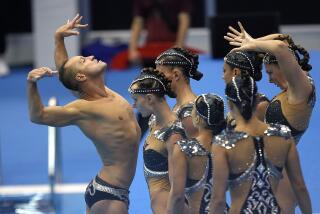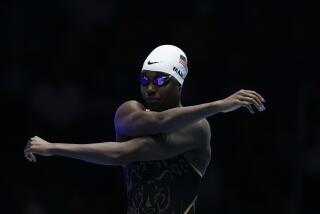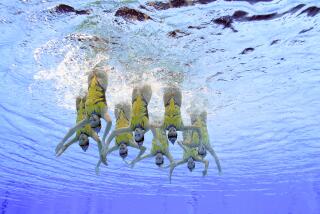Recent Deaths Focus Attention on Swim Safety
Angela Slater thought she might be wasting her time and money by enrolling her 2-year-old son, Grant, in private swimming lessons. After all, if he was still in diapers and the only word he uttered was “No,” how could he ever learn to swim?
Her doubts faded after Grant slipped away from his father and fell into the pool at their Chatsworth home last month. A few minutes later, his parents discovered the fully clothed boy in the deep end, floating on his back.
“If it wasn’t for [the swimming lessons], my son would be dead,” said Slater, 37, noting that Grant was able to swim 10 feet after 13 lessons. “He would have sunk to the bottom because his clothes were so heavy.”
Swim safety is an issue that has received heightened awareness in the past week, and instructors continue to grapple over what is the best age to teach a child to swim.
Over the weekend three children drowned in backyard swimming pools in the region. A 4-year-old boy drowned during a birthday party at rock musician Tommy Lee’s Malibu home. A 3-year-old boy in Chino drowned after being left alone for a short time in his father’s swimming pool, and a 3-year-old girl drowned after apparently falling into her family’s swimming pool in La Palma.
Group Discourages Lessons Before Age 4
Drowning is the leading cause of death in California among young children 1 to 2 years old. Statewide 107 children younger than 14 drowned in 1999, the latest year data were available, according to the state Department of Health Services.
Last year the American Academy of Pediatrics issued a policy stating that children under 4 are not developmentally ready for swim lessons.
“There was a perception that if you have a child who has swimming lessons and ‘can swim’ they are drown-proof. . . . These classes for young children were establishing a false sense of security,” said Gary Smith, director of the Center for Injury Research and Policy at Children’s Hospital in Columbus, Ohio, who helped write the AAP policy.
Aquatic programs for infants and toddlers have not been shown to decrease the risk of drowning, and small children have not developed the neuromuscular capacity required for swimming skills, according to the policy statement.
“There’s no real advantage to starting earlier,” Smith said. “If you want to have your child in the water for the enjoyment of it, that’s great. But it shouldn’t be translated to mean your child will be safe around water.”
Instructor Favors Teaching Toddlers
Infant and preschool swim programs have been developed by such organizations as the American Red Cross and the YMCA, but these programs focus more on providing enjoyment and are not designed to teach children to survive independently in the water.
“They do a lot of water comfort-type activities to make those children very happy in the water,” said Steve Willmont, executive director of the Conejo Valley YMCA in Thousand Oaks. “It’s all about making sure the child feels comfortable in the water so they are better prepared when they take swim lessons.”
Debi Habit, who taught Grant Slater to swim, believes the best age to start kids in swimming lessons is between 1 and 2.
“They need to know how to save themselves right from the get-go. You can’t say they won’t have an accident until they’re 4 years old,” said Habit, who runs the Iris Ryker Swim School in Chatsworth and has been a swim instructor for 27 years. “It’s easier for [younger children] to learn because they haven’t had years of being told about the dangers of the pool. I’ve seen kids come in at 4 and 5 years old who are petrified. For some of them, it’s harder to learn at that age.”
Safety Measures Recommended
If a child learns to swim in the summer, they need to practice year-round, said Avi Shafshak, operations manager for the Australian Swim School’s facilities in Canoga Park and Tarzana. Even swimming once a week in the winter will help them keep their skills from one swim season to the next.
“Teaching a kid to swim in the summer then not having them swim until next summer is like teaching them to ride a bike then not giving them one for six months,” he said.
With or without swim lessons, there are certain things parents can do to head off disasters.
Even if a backyard pool has a fence around it, one side is typically exposed to the house and should have a barrier to prevent children from wandering in, said Ingrid Daland, who has run the Daland Swim School in Thousand Oaks for 16 years. Pool toys should be put away when they are not being used, and the pool should have places along the side for a child to grip onto. At summer pool parties, one parent should be designated to watch the pool at all times, and children can wear a life vest for extra protection, she said.
*
Orr is a correspondent, and Stassel is a Times staff writer.
More to Read
Sign up for Essential California
The most important California stories and recommendations in your inbox every morning.
You may occasionally receive promotional content from the Los Angeles Times.










